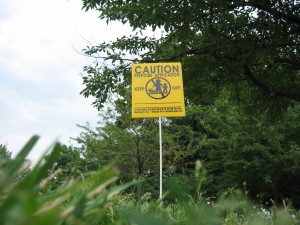04
Jun
EPA Proposes New Pesticide Discharge Permits
(Beyond Pesticides, June 4, 2010) The U.S. Environmental Protection Agency (EPA) proposed new permit requirements for the discharge of pesticides into US waterways. EPA announced the public availability of a draft National Pollutant Discharge Elimination System (NPDES) General Permit for certain pesticide use patterns, also known as the Pesticides General Permit (PGP). The agency is accepting public comments until July 19, 2010. This action stems from a 2009 court decision in the case of the National Cotton Council et al. v. EPA, in which the 6th circuit court of appeals ruled that pesticide discharges into water are pollutants and require permitting under the Clean Water Act (CWA). This ruling overturned the Bush administration policy that exempted pesticides from regulation under the CWA, and instead applied the less stringent standards of the Federal Insecticide Fungicide and Rodenticide Act (FIFRA). CWA uses a kind of health-based standard known as maximum contamination levels to protect waterways and requires permits when chemicals are directly deposited into rivers, lakes and streams, while FIFRA uses a highly subjective risk assessment that does not consider safer alternatives.
EPA will issue permits in territories, Indian Country Lands, 6 states and the District of Columbia where the Agency is the NPDES permitting authority. EPA is working closely with the other 44 states as they develop their own permit regulations. The draft PGP would allow for permitting of pesticide application for the purposes of mosquito and other flying insect pest control, aquatic weed and algae control, aquatic nuisance animal control, and forest canopy pest control. The PGP does not authorize coverage for discharges of pesticides or their degradates to waters already impaired by these specific pesticides or degradates or discharges to outstanding national resource waters. These discharges will require coverage under individual NPDES permits (see discussion of individual vs. general NPDES permits below). Also outside the scope of this permit are terrestrial applications to control pests on agricultural crops or forest floors. Irrigation return flows and agricultural stormwater runoff do not require NPDES permits, even when they contain pesticides or pesticide residues, as the CWA specifically exempts these categories of discharges from requiring NPDES permit coverage.
A NPDES permit can be written to address discharges either from an individual point source (individual permit) or from a number of similar dischargers (general permit). An individual permit is a permit specifically tailored for an individual discharger. Upon receiving the appropriate permit application(s), the permitting authority, EPA or a state, develops a draft permit for public comment for that particular discharger based on the information contained in the permit application (e.g., type of activity, nature of discharge, receiving water quality).
The proposed draft pesticide permit is a general permit. EPA believes a general permit is less burdensome on pesticide applicators and the agency. A general permit is used after determining that a set of conditions regarding discharges would be applicable to a number of similar point sources in the same geographic area. The NPDES regulations specify that the permitting authority must define the applicable geographical area and types of point sources in a general permit. Usually after a general permit is issued, dischargers that think they meet the permit’s criteria request coverage under the permit by submitting a Notice of Intent (NOI) to the permitting authority.
However, in the case of the proposed PGP, EPA is not requiring an NOI from applicators that fall below annual treatment area thresholds (mosquitoes and other flying insects: 640 acres of treatment area; aquatic weeds and algae in water: 20 acres of treatment area; aquatic weeds and algae at waters edge: 20 linear miles of treatment area; aquatic nuisance animals in water: 20 acres of treatment area; aquatic nuisance animals at waters edge: 20 linear miles of treatment area; and, forest canopy: 640 acres). EPA estimates that the PGP covers more than 30,000 applicators per year in the states for which EPA is the permitting authority. Of this total, a large majority represent applicators performing what EPA considers small pesticide treatments. EPA says it’s exempting the NOI requirement to reduce the burden on applicators and permitting authorities.
Under the proposed PGP pesticide applicators would be required to reduce pesticide discharges by using the lowest effective amount of pesticide, and prevent leaks and spills, in addition to reporting any adverse incidents. Pesticide applicators that exceed annual treatment area threshold and be required to submit an NOI, would also be required to apply integrated pest management (IPM) practices, as defined by the agency. EPA’s brand of IPM is “a program of prevention, monitoring, and control, that when done correctly can greatly reduce or eliminate the amount of pesticides used.” Before the application of a pesticide, the applicator would be required to identify the specific pests, and causes of infestation. The pesticide applicator must evaluate following management options: (1) no action, (2) preventive measures, (3) mechanical control, (4) cultural methods, and (5) biological control agents; before selecting a pesticide.
EPA estimates the regulations will affect 365,000 pesticide applicators that use an estimated 5.6 million lbs of pesticides annually. “EPA believes this draft permit strikes a balance between using pesticides to control pests and protecting human health and water quality,” said Peter S. Silva, assistant administrator for EPA’s Office of Water.
Take Action!
EPA is accepting public comments until July 19, 2010. Four public meetings and a webcast have been scheduled to present the draft permit. EPA plans to finalize the regulation in December of 2010, and will begin issuing permits in April 2011, when the court’s mandate will take effect.
Submit your comments to EPA docket number EPA-HQ-OW-2010-0257 at regulations.gov.
Source: EPA Press Release













